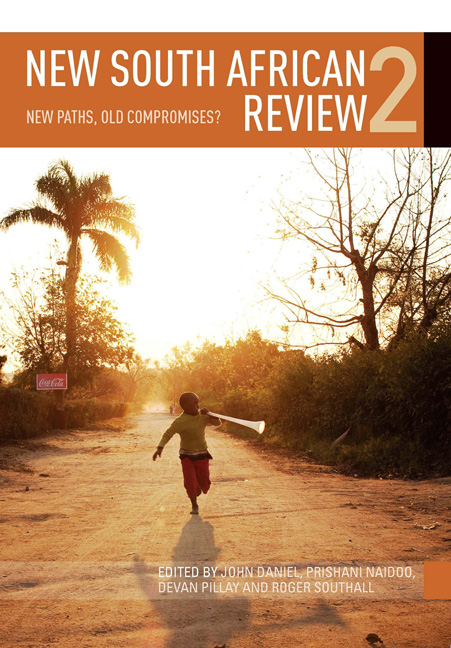Book contents
- Frontmatter
- Contents
- Preface
- Introduction: New paths, old (com)promises?
- PART 1 POLITICS AND INTERNATIONAL
- Introduction: The Zuma presidency: The politics of paralysis?
- Chapter 1 The Tripartite Alliance and its discontents: Contesting the ‘National Democratic Revolution’ in the Zuma era
- Chapter 2 The African National Congress and the Zanufication debate
- Chapter 3 Dancing like a monkey: The Democratic Alliance and opposition politics in South Africa
- Chapter 4 Democracy and accountability: Quo Vadis South Africa?
- Chapter 5 Civil society and participatory policy making in South Africa: Gaps and opportunities
- Chapter 6 Bring back Kaiser Matanzima? Communal land, traditional leaders and the politics of nostalgia
- Chapter 7 South Africa and ‘Southern Africa’: What relationship in 2011?
- PART 2 ECONOMY AND SOCIETY
- PART 3 ENVIRONMENT
- PART 4 MEDIA
- Contributors
- Index
Chapter 7 - South Africa and ‘Southern Africa’: What relationship in 2011?
from PART 1 - POLITICS AND INTERNATIONAL
Published online by Cambridge University Press: 23 March 2018
- Frontmatter
- Contents
- Preface
- Introduction: New paths, old (com)promises?
- PART 1 POLITICS AND INTERNATIONAL
- Introduction: The Zuma presidency: The politics of paralysis?
- Chapter 1 The Tripartite Alliance and its discontents: Contesting the ‘National Democratic Revolution’ in the Zuma era
- Chapter 2 The African National Congress and the Zanufication debate
- Chapter 3 Dancing like a monkey: The Democratic Alliance and opposition politics in South Africa
- Chapter 4 Democracy and accountability: Quo Vadis South Africa?
- Chapter 5 Civil society and participatory policy making in South Africa: Gaps and opportunities
- Chapter 6 Bring back Kaiser Matanzima? Communal land, traditional leaders and the politics of nostalgia
- Chapter 7 South Africa and ‘Southern Africa’: What relationship in 2011?
- PART 2 ECONOMY AND SOCIETY
- PART 3 ENVIRONMENT
- PART 4 MEDIA
- Contributors
- Index
Summary
South Africa is the only African country to take the name of a geographical part of the continent, and therefore it is customary to speak and write of ‘Southern Africa’ to distinguish the region from the country formed in 1910. Those who founded the Union of South Africa chose that name for the country in part because they expected the Union to expand to embrace much, if not all, of the southern half of the continent. In the event, the expected expansion of South Africa to the north to incorporate, at a minimum, Southern Rhodesia and the then High Commission Territories of Basutoland, Bechuanaland and Swaziland, did not happen, and what is now Namibia was never formally annexed, so the boundaries of the South Africa of 1910 remain today virtually the same as they were then (Chanock, 1997; Hyam, 1972). Nevertheless, the history and prospects of South Africa remain closely bound up with those of the neighbouring countries in the region of which it is part, and for that reason the first number of the South African Review, published in 1983, began with a section on ‘South Africa and Southern Africa’ (South African Research Service, 1983).
Long before 1910, people living in the area encompassed by the state called South Africa had been involved, in many different ways, with those living further north in Africa, not least through the extensive migrant labour routes that criss-crossed the continent. Such ties continued, and were extended, after 1910. For a decade, from the late 1970s, South Africa engaged in a war of terror against its neighbours to try to prevent largely ANC-aligned guerrillas based in those countries from undertaking operations in the struggle to end the apartheid regime. The death and destruction wreaked on the region by apartheid South Africa in that period stands as one of the lesser acknowledged crimes of the twentieth century. The Truth and Reconciliation Commission's final report found that this campaign of military aggression ‘constituted violations of the sovereignty of the countries involved and an infringement of the principles of international law’ (TRC, 1998: Vol. 2, 154). Since 1994, a quite different set of relations has developed between South Africa and ‘Southern Africa’, and it is some of these that this chapter explores.
- Type
- Chapter
- Information
- New South African Review 2New paths, old compromises?, pp. 142 - 154Publisher: Wits University PressPrint publication year: 2012



